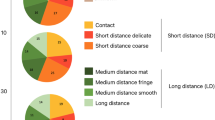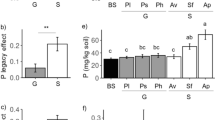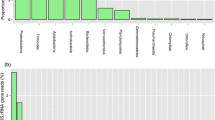Abstract
Allelopathic effects of invasive plants on native flora may be mitigated by the abiotic and biotic environment into which the allelochemicals are released. Lonicera maackii (Amur honeysuckle), an invasive plant of the eastern deciduous forest, suppresses seed germination in laboratory assays. We investigated how L. maackii leachate interacts with abiotic conditions and with the soil microbial community. First, we tested the effects of leaf extract from L. maackii on germination of the native woodland herb, Blephilia hirsuta, under different light and soil conditions. We found that germination of Blephilia hirsuta was reduced by L. maackii extract, but abiotic conditions did not interact with this effect. We also tested the effects of leaf extract on germination of five native woodland species and L. maackii placed in sterile or live soil. There was an overall suppressive effect of L. maackii extract on itself and the other five native species tested. However, L. maackii extract interacted with live soil in ways that differed with the species being tested and, in some cases, changed over time. Our results indicate that allelopathic potential of L. maackii shows context dependency with respect to soil microorganisms and native species identity but not to light conditions or soil type. Our results imply that restoration of invaded areas may require active reintroduction of species sensitive to allelopathy in live soil. Further, laboratory assays of allelopathy should consider the interaction of allelochemicals with biotic and abiotic conditions to more accurately predict the impacts of allelopathy on plant communities.


Similar content being viewed by others
References
Anderson RC, Anderson MR, Bauer JT, Slater M, Herold JM, Baumhardt VA (2010) Effect of removal of garlic mustard (Alliaria petiolata Brassicaceae) on Arbuscular Mycorrhizal Fungi inoculum potential in forest soils. Open Ecol J 3:41–47
Bartuszevige AM, Gorchov DL (2006) Avian seed dispersal of an invasive shrub. Biol Invasions 8:1013–1022
Brudvig LA, Mabry CM, Mottl LM (2011) Dispersal, not understory light competition, limits restoration of Iowa woodland understory herbs. Restor Ecol 19:24–31
Callaway RM, Aschehoug ET (2000) Invasive plants versus their new and old neighbors: a mechanism for exotic invasion. Science 290:521–523
Callaway RM, Ridenour WM (2004) Novel weapons: invasive success and the evolution of increased competitive ability. Front Ecol Environ 2:436–443
Cipollini D, Dorning M (2008) Direct and indirect effects of conditioned soils and tissue extracts of the invasive shrub, Lonicera maackii, on target plant performance. Castanea 73:166–176
Cipollini D, Stevenson R, Enright S, Eyles A, Bonello P (2008) Phenolic metabolites in leaves of the invasive shrub, Lonicera maackii, and their potential phytotoxic and anti-herbivore effects. J Chem Ecol 34:144–152
Cumming JR, Kelly CN (2007) Pinus virginiana invasion influences soils and arbuscular mycorrhizae of a serpentine grassland. J Torrey Bot Soc 134:63–73
Dorning M, Cipollini D (2006) Leaf and root extracts of the invasive shrub, Lonicera maackii, inhibit seed germination of three herbs with no autotoxic effects. Plant Ecol 184:287–296
Gomez-Aparicio L, Canham CD (2008) Neighbourhood analyses of the allelopathic effects of the invasive tree Ailanthus altissima in temperate forests. J Ecol 96:447–458
Gorchov DL, Trisel DE (2003) Competitive effects of the invasive shrub, Lonicera maackii (Rupr.) Herder (Caprifoliaceae), on the growth and survival of native tree seedlings. Plant Ecol 166:13–24
Gough L, Shaver GR, Carroll J, Royer DL, Laundre JA (2000) Vascular plant species richness in Alaskan arctic tundra: the importance of soil pH. J Ecol 88:54–66
Grime JP (2002) Plant strategies, vegetation processes, and ecosystem properties. Wiley, New York
Hartman KM, McCarthy BC (2008) Changes in forest structure and species composition following invasion by a non-indigenous shrub, Amur Honeysuckle (Lonicera maackii). J Torrey Bot Soc 135:245–259
Hierro JL, Callaway RM (2003) Allelopathy and exotic plant invasion. Plant Soil 256:29–39
Hughes JW, Fahey TJ (1991) Colonization dynamics of herbs and shrubs in a disturbed northern hardwood forest. J Ecol 79:605–616
Hutchinson TF, Vankat JL (1997) Invasibility and effects of Amur Honeysuckle in southwestern Ohio forests. Conserv Biol 11:1117–1124
Inderjit (2005) Soil microorganisms: an important determinant of allelopathic activity. Plant Soil 274:227–236
Inderjit, van der Putten WH (2010) Impacts of soil microbial communities on exotic plant invasions. Trends Ecol Evol 25:512–519
Inderjit, Bajpai D, Rajeswari MS (2010) Interaction of 8-hydroxyquinoline with soil environment mediates its ecological function. PLoS ONE 5:e12852
Jarchow ME, Cook BJ (2009) Allelopathy as a mechanism for the invasion of Typha angustifolia. Plant Ecol 204:113–124
Kaur H, Kaur R, Kaur S, Baldiwin IT, Inderjit (2009) Taking ecological function seriously; soil microbial community can obviate allelopathic effects of released metabolites. PLoS ONE 4:e4700
Lankau R (2010) Soil microbial communities alter allelopathic competition between Alliaria petiolata and a native species. Biol Invasions 12:2059–2068
Luken JO, Kuddes LM, Tholemeier TC (1997) Response of understory species to gap formation and soil disturbance in Lonicera maackii thickets. Restor Ecol 5:229–235
McEwan RW, Birchfield MK, Schoergendorfer A, Arthur MA (2009) Leaf phenology and freeze tolerance of the invasive shrub Amur Honeysuckle and potential native competitors. J Torrey Bot Soc 136:212–220
McEwan RW, Arthur-Paratley LG, Rieske LK, Arthur MA (2010) A multi-assay comparison of seed germination inhibition by Lonicera maackii and co-occurring native shrubs. Flora 205:475–483
McGrath DA, Binkley MA (2009) Microstegium vimineum invasion changes soil chemistry and microarthropod communities in Cumberland Plateau forests. Southeast Nat 8:141–156
McKinney AM, Goodell K (2010) Shading by invasive shrub reduces seed production and pollinator services in a native herb. Biol Invasions 12:2751–2763
Miller KE, Gorchov DL (2004) The invasive shrub, Lonicera maackii, reduces growth and fecundity of perennial forest herbs. Oecologia 139:359–375
Pisula NL, Meiners SJ (2010) Relative allelopathic potential of invasive plant species in a young disturbed woodland. J Torrey Bot Soc 137:81–87
Pollock JL, Callaway RM, Thelen GC, Holben WE (2009) Catechin-metal interactions as a mechanism for conditional allelopathy by the invasive plant Centaurea maculosa. J Ecol 97:1234–1242
Rudrappa T, Choi YS, Levia DF, Legates DR, Lee KH, Bais HP (2009) Phragmites australis root secreted phytotoxin undergoes photo-degradation to execute severe phytotoxicity. Plant Signal Behav 4:506–513
Stinson KA, Campbell SA, Powell JR, Wolfe BE, Callaway RM, Thelen GC, Hallett SG, Prati D, Klironomos JN (2006) Invasive plant suppresses the growth of native tree seedlings by disrupting belowground mutualisms. PLoS Biol 4:727–731
Tharayil N, Bhowmik PC, Xing BS (2006) Preferential sorption of phenolic phytotoxins to soil: implications for altering the availability of allelochemicals. J Agric Food Chem 54:3033–3040
Verdu M, Traveset A (2005) Early emergence enhances plant fitness: a phylogenetically controlled meta-analysis. Ecology 86:1385–1394
Vidra RL, Shear TH, Stucky JM (2007) Effects of vegetation removal on native understory recovery in an exotic-rich urban forest. J Torrey Bot Soc 134:410–419
Weir TL, Bais HP, Stull VJ, Callaway RM, Thelen GC, Ridenour WM, Bhamidi S, Stermitz FR, Vivanco JM (2006) Oxalate contributes to the resistance of Gaillardia grandiflora and Lupinus sericeas to a phytotoxin produced by Centaurea maculosa. Planta 223:785–795
Zhu XZ, Zhang JT, Ma KP (2011) Soil biota reduce allelopathic effects of the invasive Eupatorium adenophorum. PLoS ONE 6:6
Acknowledgments
José Aguilar and Adriaunna Smith assisted with pilot studies that informed these experiments, and their contributions were supported through the Indiana University Department of Biology Lilly Scholars Program. The Cox Research Scholarship Program at Indiana University supported R. E. Stoops and the Floyd Fellowship program at Indiana University supported J. T. Bauer and S. M. Shannon. The Amos W. Butler Audubon Society and the Indiana Native Plant and Wildflower Society also provided funding for this study.
Author information
Authors and Affiliations
Corresponding author
Rights and permissions
About this article
Cite this article
Bauer, J.T., Shannon, S.M., Stoops, R.E. et al. Context dependency of the allelopathic effects of Lonicera maackii on seed germination. Plant Ecol 213, 1907–1916 (2012). https://doi.org/10.1007/s11258-012-0036-2
Received:
Accepted:
Published:
Issue Date:
DOI: https://doi.org/10.1007/s11258-012-0036-2




